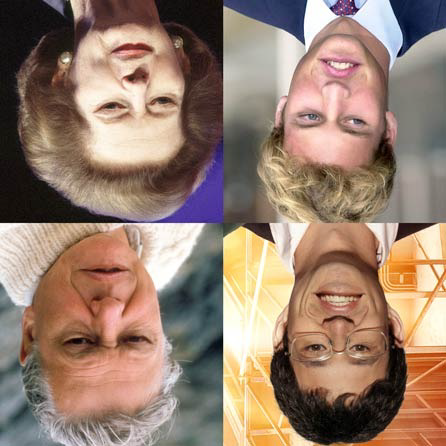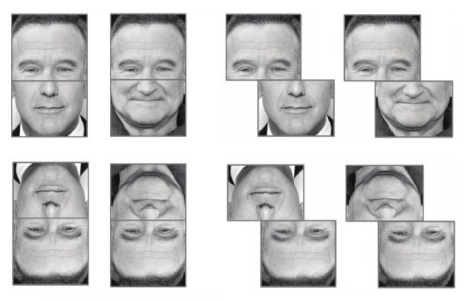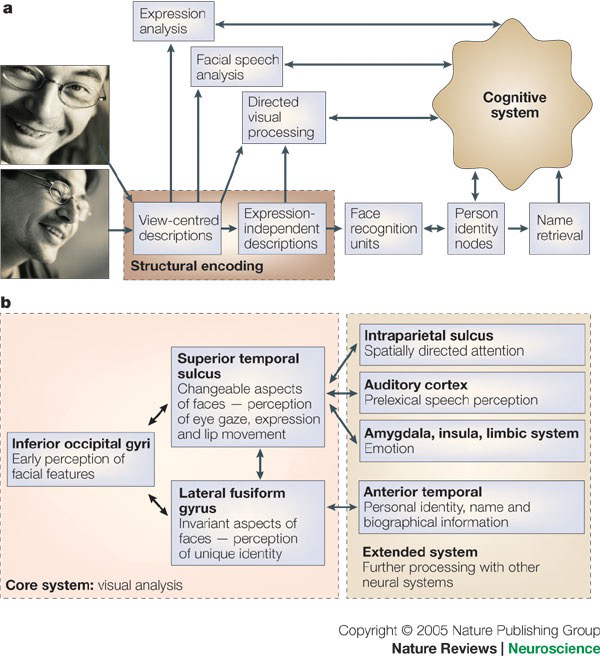Face processing and its disorders
Learning objectives
Understand the cognitive and neural basis of face perception
Understand differential processes involved in holistic and configural processing
Understand how differences between familiar and unfamiliar faces provide a basis for understanding how faces are learnt
Understand cases of face processing deficits in various disorders (prosopagnosia, ASD)
Basic of face perception and theories
There are generally two types of coding: holistic processing, configural progressing.
Evidence
Evidences for holistic coding: Inversion Effects (Yin, 1969), The Thatcher Effect (Thomson,1980), The composite and part whole effect (Young et al., 1987, Tanaka & Farah, 1993).
Inversion effect

Face perception is disproportionately impaired by inversion. The argument: upright and inverted faces are processed in qualitatively different ways. The argument: upright and inverted faces are processed in qualitatively different ways
Thatcher effect

it becomes more difficult to detect local feature changes in an upside-down face
not face specific (Wong et al., 2010; Johnston et al., 2014).
The composite face effect

when the top half of one face was aligned with the bottom half of another, the resulting composite arrangement induced the perception of a novel facial configuration; the presence of the bottom half altered the appearance of the top half, and vice versa (Young, Hellawell and Hay, 1987)
but it is not observed for other objects like cars (e.g., Cassia et al., 2009).
Theories
Are faces special (different from objects) ?
Evidence
Behavioural evidence
Inversion impairs facial recognition to a greater extent than object recognition (e.g. Yin, 1969; Diamond & Carey, 1987).
Composite effects observed for faces, but not other objects like cars (e.g., Cassia et al., 2009).
Inversion effects for objects of expertise (Diamond & Carey, 1986; Gauthier & Tarr, 1997).
Thatcher effect not face specific (Wong et al., 2010; Johnston et al., 2014).
Composite effects for objects of expertise (Anstis, 2005; Richler et al., 2009 Gauthier et al., 2003)
Brain
FMRI evidence

most findings show normal activation, perhaps an issue of WM myelination
EEG evidence
less selectivity in N170 (N170 is the component associated to the neural processing of faces), no inversion effects, standard repetition suppression effects
CAUSAL evidence – TMS/BRAIN STIM
TMS to the OFA disrupts face perception abilities (Pitcher et al., 2007), but also inverted faces (Pitcher et al., 2011).
*tDCS *of OFA enhances the perception of both faces and objects (Barbieri et al., 2016).
Failure
PROSOPAGNOSIA (ACQUIRED PROSOPAGNOSIA and DEVELOPMENTAL PROSOPAGNOSIA)
Diagnosis
Formal diagnosis not defined by DSM-V. Standard batteries rely on subjective self-report questionnaires and objective behavioural tests.
The twenty-item Prosopagnosia Index (PI20)
There a conflict between domain-specific and domain general
NEURAL ACCOUNTS
Findings
functional
The impairment in DP may arise not from a dysfunction of the core areas, but from a failure to propagate signals between areas of the network.
structural
The reduced grey matter volume is found in DPs in inferior temporal lobe, STS, FFA, associated with face recognition performance.
reduced grey matter volume, potential connectivity issues between core and extended regions
Genetics
inherited aspect to face recognition abilities
Summary
Faces are thought to be processed holistically, but controversy still remains.
Whether faces are processed by dedicated perceptual and neural mechanisms remains unclear, different from objects but possibly not objects of expertise.
Evidence of specificity from neural and behavioural studies, but difficulty dissociating faces from objects of expertise.
Two types of prosopagnosia can account for vast majority of individual differences in perception ability, but testing methods are slow and variable.
Neural accounts go far in explaining the heterogeneity of the ability, but many questions about familiarity, viewpoint, propagation of signal, etc. remain.
Vocabularies
Prosopagnosia: the condition of not being able to recognize the faces of people who are know to you, often caused by damage to the brain


